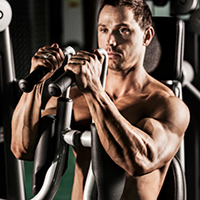 Have You Reached Your Full Potential?
Have You Reached Your Full Potential?
You may never know if you’ve ever reached your peak in weight training, and in all honesty, you’re body always keeps going and won’t stop unless you stop! You’ve most likely set yourself goals and you’ve finally become satisfied with the way you look and feel. This can be considered the peak that you’ve reached, however, you may feel unsatisfied with where you at so you set yourself higher goals to reach that satisfied feeling with yourself! This article will help you to reach your peak potential and help you to understand when you have achieved your full potential!
Now if you feel like you haven’t reached your peak in your weight training, keep reading on to get tips on how to get to that full potential. Now the reason you probably feel like your have achieved this goal in your weight training journey is because you haven’t altered your regimen. It’s important to know that there is always room for potential and to keep pushing yourself to reach your next goal in becoming the person you dream of becoming! Bodybuilding.com compiled a list of tips that will help you get to the point where you want to be.
How To Reach Your Peak Potential?
As it was just mentioned, the reason you probably haven’t reached your peak in muscle building is because you haven’t switched up your workout regimen. By adjusting your regimen and pushing your body little by little you’ll end up achieving your end all goals. Try these tips below that were put together by Bodybuilding.com.
- Change Your Exercise Selection.
- If you’re the type of person who sticks to routine, you may want to switch it up with other lifting routines for a few weeks. The changes in exercise will alter the stress being placed on the body and can produce faster strength adaptations. Choose exercises that focus on the weak points of the lifts you want to improve.
- Accelerate
- It is said that some of the strongest power lifters in the world spend half of their training time working on accelerating light weights quickly. When they’re moving heavy weight, they’re always trying to move them fast. They’re trying to increase the rate of force production. You tend to recruit more muscles when you move weight quickly.
- Check Your Breathing
- By using correct breathing techniques, like exhaling or holding your breath on the contraction portion of the movement can help your body generate maximum force capacity. It’s typical for people to forget about their breathing while working out and many don’t even know the importance it holds to their workouts as well.
- Doing Warm Up Sets.
- This gets the muscle cell motor units firing. It can help to circulate blood so oxygen and nutrients get delivered to muscle cells. This can also help delay fatigue so you’re able to withstand heavier weight for longer.
- Eat Plenty Before Each Workout.
- Make sure you eat enough and properly before each workout, so that your body is able to burn through all that food and fuel it for energy. It is said that if you aren’t taking in any form of glucose prior to your weightlifting session, you won’t have the energy levels to perform the way you want. Try eating complex carbs and proteins before a workout.
- Take A Few Days Off
- Don’t teeter on the verge of over training. Being in the gym multiple times a week without giving your body the rest it needs to recover, you won’t build your muscles.
- Take Nitric Oxide
- This will help to enhance your strength by dilating your blood vessels. When your blood vessels are dilated you get greater oxygen delivery to your muscles.
- Slow Down On The Volume
- Keep your reps low, even on warm up sets. Do fewer exercises, putting the bulk of the volume into your primary movement. Do less overall volume. A couple dozen sets for one muscle group can be almost normal, but there is no way you’re going to maintain your strength through that duration.
- Cut Out Isolation Exercises
- These exercises drain your recovery reserves, leaving you less able to give your best effort on compound movements.
- Stretch!
- This helps to increase dynamic flexibility and improve joint mobility. Don’t static stretch the primary mover, but dynamically stretch it.
